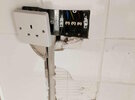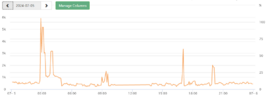- Joined
- 6 Jul 2024
- Messages
- 3
- Reaction score
- 0
- Country

I just feel the need to check a couple of things and hope somebody can repsond.
My kitchen has a Bosch plug in oven (2.4kw) plugged in to a socket near the oven. This then goes to a fused switch above the worktop with 13amp fuse (switch says Ignition but oven is plugged in).
This is the socket before it was finished. The cooker connection is on its own circuit and the socket is on the same circuit as other sockets in the kitchen (this one is has the wording "Ignition" and is 13amp). Hope I am giving enough info here. This all does look MUCH better than is this picture but is behind oven so I can't take a new photo.
Is it OK that the oven is plugged into this socket with the 13amp fused switch up on the wall?

The kitchen also has a 2 zone Montpellier induction hob 20amp which is hardwired into the cooker connection behind the oven.
Is it fine for hob to be wired into the cooker connection?

My kitchen has a Bosch plug in oven (2.4kw) plugged in to a socket near the oven. This then goes to a fused switch above the worktop with 13amp fuse (switch says Ignition but oven is plugged in).
This is the socket before it was finished. The cooker connection is on its own circuit and the socket is on the same circuit as other sockets in the kitchen (this one is has the wording "Ignition" and is 13amp). Hope I am giving enough info here. This all does look MUCH better than is this picture but is behind oven so I can't take a new photo.
Is it OK that the oven is plugged into this socket with the 13amp fused switch up on the wall?

The kitchen also has a 2 zone Montpellier induction hob 20amp which is hardwired into the cooker connection behind the oven.
Is it fine for hob to be wired into the cooker connection?

